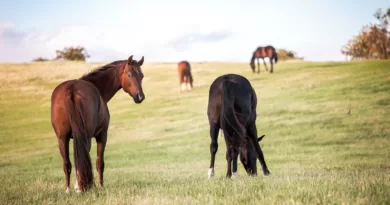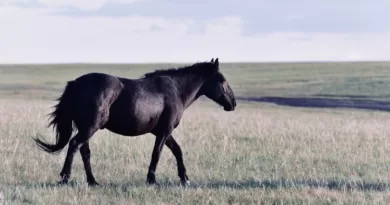Is a Water Horse Real
What is a Water Horse?
A water horse, also known as kelpie or each uisge, is a mythical creature that appears in legends and folklore across different cultures. It is typically described as a shape-shifting creature that resides in bodies of water such as rivers, lakes, and seas. The water horse is often portrayed as a powerful and mysterious being, capable of both captivating and terrifying those who encounter it.
One of the distinctive characteristics of a water horse is its ability to change its appearance. It can appear as a beautiful and alluring creature, enticing people to approach it. However, once someone is close enough, the water horse reveals its true nature, often taking the form of a monstrous and dangerous creature. This duality in its appearance serves as a cautionary element, warning against the dangers of being lured by the unknown and the deceptive nature of appearances.
The Mythical Origins of the Water Horse
The mythical origins of the water horse can be traced back to ancient folklore and legends that have been passed down through generations. These stories often depict the water horse as a enigmatic and mysterious creature, with the ability to shape-shift between its natural equine form and that of a magical water-dwelling being. In Celtic mythology, for example, the water horse is known as a “each uisge” or “kelpie,” and is believed to inhabit lakes and rivers, luring unsuspecting victims to their watery demise.
Similar legends of water horses can be found in different cultures around the world, each with their own unique variations and beliefs. In Scandinavian folklore, the water horse is known as the “nykur,” a creature that haunts rivers and streams, enticing people to ride on its back before plunging them underwater. In Slavic mythology, the water horse is known as the “vodyanoy,” a malevolent creature that dwells in bodies of water and drowns those who cross its path. These diverse cultural depictions of water horses highlight the enduring fascination and fear that humans have had towards these mythical beings throughout history.
Cultural Depictions of Water Horses
Throughout history, water horses have been subjects of fascination and intrigue in various cultures around the world. From ancient mythology to modern literature, these mythical creatures have captured the imagination of people from different walks of life. In Celtic folklore, the water horse is known as the kelpie, a shape-shifting creature often depicted as a horse with a single fin-like appendage or webbed hooves. In Scottish tales, the kelpie is said to lure unsuspecting individuals to its underwater lair, where it devours them. The kelpie is often seen as a cautionary figure, warning people about the dangers of water bodies and the unknown.
Asian cultures also have their own interpretations of water horses. In Japanese folklore, the creature is known as the kappa. Portrayed as a mischievous water spirit resembling a turtle or monkey, the kappa is known for its love of cucumber and its ability to drag victims into rivers or ponds. Similar to the kelpie, the kappa serves as a reminder to be cautious around water and to respect the power it holds. These cultural depictions of water horses not only reflect the collective beliefs and fears of their respective societies but also provide a glimpse into humanity’s fascination with the mysterious and the supernatural.
The Different Names for Water Horses Around the World
Water horses, known by various names across the world, have captivated the imaginations of different cultures for centuries. In Scotland, they are referred to as the “each-uisge,” which translates to “water horse” in Gaelic. These mythical creatures are said to haunt the country’s lochs, luring unsuspecting travelers to their doom. In Ireland, they are known as “dobharchú” or “dearg-due,” often depicted as shape-shifting creatures with sinister intentions. Legends of these water horses have been passed down through generations, serving as cautionary tales that emphasize the dangers of the water.
Across the Atlantic Ocean in North America, indigenous tribes have their own variations of water horse legends. For example, among the Ojibwe people, a water horse-like creature known as the “pukwudgie” is said to inhabit bodies of water, particularly lakes and rivers. They are believed to have magical powers, capable of both helping and harming humans. Similarly, the Algonquian tribes tell stories of “mishipeshu,” a water lynx with the ability to control weather and protect sacred sites. These diverse names and depictions highlight the extensive cultural significance of water horse legends worldwide.
Similar Creatures in Folklore and Mythology
In various cultures around the world, tales of mythical creatures similar to water horses can be found in folklore and mythology. These creatures often share common characteristics with water horses, such as their affinity for bodies of water and their mysterious and powerful nature. One such creature is the Kelpie, a water-dwelling spirit commonly found in Scottish folklore. Described as a shape-shifting creature that takes the form of a horse, the Kelpie is said to lure unsuspecting victims to their watery demise. Though similar to water horses, the Kelpie is often portrayed as more sinister and malevolent.
Another creature with similarities to water horses is the Nuckelavee from Orcadian mythology. This creature is said to be a terrifying sea monster with a horse’s head and a humanoid torso, appearing as a grotesque amalgamation of both land and sea. The Nuckelavee is known for causing widespread destruction and disease wherever it goes, particularly targeting livestock and crops. Its close association with the ocean and its destructive tendencies align it with the characteristics attributed to water horses in other cultures.
Historical Accounts of Water Horse Sightings
In various cultures around the world, there have been numerous accounts of sightings and encounters with water horses throughout history. These mythical creatures have been described as large, powerful beasts often with a combination of characteristics from horses and aquatic creatures. While the specific details may vary, the common thread among these historical accounts is the awe and fear that water horses evoke in those who have witnessed them.
Recorded sightings of water horses can be found in folklore and historical documents from different regions. For example, in Scottish folklore, there is the well-known tale of the Loch Ness Monster, a water horse said to inhabit the depths of Loch Ness. Similarly, in Irish mythology, there are tales of the Each-Úisge, a shape-shifting water horse known for enticing unsuspecting riders into the water to their doom. These historical accounts continue to capture the imagination of people around the world, fueling the ongoing fascination with water horses and their elusive existence.
Exploring the Characteristics and Abilities of Water Horses
Water horses, also known as kelpies or each uisge, are intriguing mythical creatures that have captured the imagination of people around the world. These powerful beings are often depicted as horses with the ability to shape-shift into humans, sometimes appearing as beautiful maidens in order to lure unsuspecting victims into their clutches. One of the most fascinating characteristics attributed to water horses is their affinity for water – they are said to live in lochs, rivers, and sea, making them elusive and mysterious creatures.
Legend has it that water horses possess an irresistible allure, drawing people towards them through their enchanting songs or captivating eyes. Once entranced, victims find themselves unable to resist riding the water horse, only to be carried away to their watery doom. This ability to both mesmerize and manipulate their prey showcases the cunning and intelligence of these elusive creatures. Despite their reputation for being dangerous, water horses are also believed to have the power to grant wishes, making them creatures both feared and revered in folklore.
Water Horses in Literature and Popular Culture
Water horses have captivated the imaginations of storytellers, writers, and filmmakers, showcasing their allure and mystique throughout various forms of literature and popular culture. These majestic creatures have often been depicted as both beautiful and dangerous, playing key roles in many narratives. In fantasy novels, water horses are often portrayed as powerful and untamed beings, living in hidden lakes or deep ocean realms. Their presence serves to evoke a sense of wonder and danger, providing an intriguing backdrop for heroes and heroines to navigate.
In popular culture, water horses have also made their mark, becoming iconic figures in movies and television shows. Their appearances range from the elegant and gentle companions of mermaids to the cunning and malevolent creatures meant to scare and thrill audiences. With each portrayal, water horses continue to fascinate, captivating viewers with their duality of grace and ferocity. By offering an imaginative glimpse into a world where mythical creatures exist, the inclusion of water horses in literature and popular culture allows for the exploration of themes such as power, transformation, and the unpredictable forces of nature.
Scientific Explanations for Water Horse Legends
Scientific explanations have long sought to demystify the legends surrounding water horses. One theory proposes that these mythical creatures may have originated from misidentifications of real animals. For example, the manatee, also known as the “sea cow,” bears a resemblance to descriptions of water horses, with its large size and rounded shape. It is conceivable that early seafarers encountering manatees in unfamiliar waters could have mistaken them for mysterious water horses, perpetuating the legends.
Another scientific explanation suggests that water horse legends may have arisen from the behavior of certain species of fish. Some fish, such as the pike, are known to lie in wait near the water’s surface, appearing suddenly to snatch their prey. This swift and alarming movement may have sparked tales of water horses emerging from the depths of lakes and rivers. Additionally, certain fish species like the mudfish have the ability to survive in damp areas for extended periods, potentially contributing to beliefs in creatures that can transition between land and water. These scientific possibilities offer intriguing insights into the origins of water horse legends, challenging our perceptions of mythical creatures and the fine line between reality and imagination.
The Impact of Water Horse Legends on Local Communities
Water horse legends have had a profound impact on the local communities that embrace these mythical creatures as part of their cultural heritage. These legends often serve as a source of pride and identity for these communities, as they are deeply intertwined with their history and folklore. The tales of water horses have been passed down through generations, contributing to a sense of belonging and shared experiences among the residents.
The impact of water horse legends extends beyond cultural significance. In some cases, these mythical creatures have become the focal point of tourism, attracting visitors from far and wide who are eager to learn more about the local traditions and beliefs surrounding water horses. This influx of tourists can bring economic benefits to these communities, with establishments such as hotels, restaurants, and souvenir shops flourishing as a result. Moreover, the recognition of water horse mythology can also lead to the preservation and promotion of local traditions, as communities strive to showcase their unique cultural heritage to the world.
What is a water horse?
A water horse is a mythical creature that is believed to inhabit bodies of water such as lakes, rivers, and seas.
What are the mythical origins of the water horse?
The origins of water horse legends vary across different cultures and folklore. In some legends, water horses are believed to be shape-shifting spirits or creatures that lure humans into the water.
How are water horses depicted in different cultures?
Water horses are depicted differently in various cultures. In some traditions, they are seen as beautiful and majestic creatures, while in others, they are portrayed as dangerous and malevolent beings.
What are the different names for water horses around the world?
Water horses are known by different names in various cultures. Some common names include kelpie (Scotland), nuggle (Ireland), nykur (Iceland), and each-uisge (Scotland).
Are there similar creatures in folklore and mythology?
Yes, there are similar creatures in folklore and mythology around the world. For example, the selkie in Scottish folklore and the mermaid in various mythologies share similarities with water horses.
Are there any historical accounts of water horse sightings?
Yes, there have been historical accounts of water horse sightings, especially in regions where water horse legends are prevalent. These sightings often describe encounters with mysterious creatures in bodies of water.
What are the characteristics and abilities of water horses?
Water horses are often described as being able to shape-shift, enticing humans into the water, and possessing great strength. They are also believed to have the ability to drown their victims.
How are water horses portrayed in literature and popular culture?
Water horses have been featured in various works of literature and popular culture. They are often depicted as magical creatures that play significant roles in the stories they appear in.
Are there scientific explanations for water horse legends?
While water horse legends are primarily rooted in folklore and mythology, there are scientific explanations that could account for some reported sightings. These explanations typically involve misidentifications of real animals or natural phenomena.
What impact do water horse legends have on local communities?
Water horse legends can have a significant impact on local communities. They shape cultural beliefs, influence tourism, and contribute to the preservation of local folklore and traditions.




